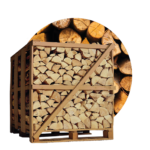Introduction
South Africa boasts a diverse and unique ecosystem, but the introduction of invasive species poses a significant threat to its native plants and wildlife. One such invasive species is the Silver Wattle (Acacia dealbata). In this blog post, we will delve into the menace of Silver Wattle in South Africa and explore how harvesting it for firewood can be a sustainable solution that benefits the environment.
Understanding the Threat of Silver Wattle
Silver Wattle, originally native to southeastern Australia, was introduced to South Africa in the late 19th century for its ornamental appeal and potential timber production. Unfortunately, it has since become a serious invasive species, spreading rapidly across the country's landscapes. Here's why it's a cause for concern:
Aggressive Growth: Silver Wattle is a fast-growing tree that outcompetes native vegetation. Its rapid spread can lead to the displacement of local plant species, reducing biodiversity.
Altered Ecosystems: The invasion of Silver Wattle can alter entire ecosystems by changing soil chemistry and moisture levels, further exacerbating its negative impact on native flora and fauna.
Fire Hazard: Silver Wattle has a high oil content, making it extremely flammable. This increases the risk of wildfires, which can devastate both natural and human habitats.
Harvesting Silver Wattle for Firewood
While Silver Wattle poses a significant threat to South Africa's environment, there is a silver lining to this invasive species. Harvesting it for firewood offers an environmentally friendly way to mitigate its impact and provides several benefits:
Reduces Spread: By selectively harvesting Silver Wattle, we can control its population and prevent further invasion into natural habitats.
Provides Sustainable Firewood: Silver Wattle, when properly seasoned, makes for excellent firewood. It burns hot and efficiently, making it an attractive option for heating homes and cooking.
Economic Opportunities: Harvesting and selling Silver Wattle firewood can create economic opportunities for local communities, boosting income and employment in rural areas.
Lessens Fire Risk: Removing Silver Wattle from areas at risk of wildfires can reduce the likelihood of large, destructive fires, safeguarding both natural ecosystems and human settlements.
Promotes Native Regrowth: By clearing Silver Wattle, we allow native South African plants to regrow, restoring the balance of local ecosystems.
Harvesting Silver Wattle Responsibly
While harvesting Silver Wattle for firewood is a promising solution, it must be done responsibly to minimize environmental impact. Here are some key guidelines to follow:
Selective Cutting: Only cut mature Silver Wattle trees, leaving younger ones to continue absorbing carbon dioxide and supporting the ecosystem.
Proper Seasoning: Ensure the harvested wood is properly seasoned to maximize its efficiency and minimize smoke emissions.
Compliance with Regulations: Always adhere to local and national regulations regarding invasive species management and firewood harvesting.
Promote Native Species: Consider planting native South African trees and plants to replace Silver Wattle in areas where it has been removed.
Conclusion
The Silver Wattle invasion in South Africa poses a severe threat to the country's ecosystems, but it also presents an opportunity for sustainable environmental management. By responsibly harvesting Silver Wattle for firewood, we can control its spread, reduce fire hazards, and create economic opportunities for local communities. This approach not only benefits the environment but also contributes to a more sustainable future for South Africa's unique and diverse landscapes. It's time to turn this invasive species into a valuable resource for the nation's well-being.



